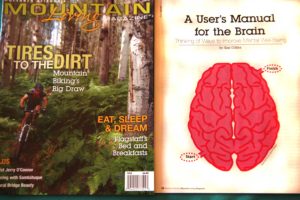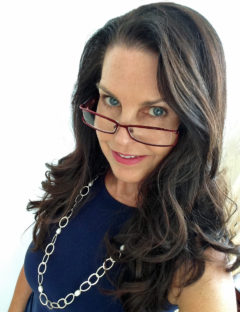![]() June 2010
June 2010
 Mary suffered from insomnia for years. The challenges of balancing a high-powered job and a blended family created stress in the important areas of her life. She met her fiftieth birthday sleep-deprived and depressed. After repeated efforts by her primary care doctor failed, Mary (who asked her full name not be used) sought integrated help at the Center for Creative Change.
Mary suffered from insomnia for years. The challenges of balancing a high-powered job and a blended family created stress in the important areas of her life. She met her fiftieth birthday sleep-deprived and depressed. After repeated efforts by her primary care doctor failed, Mary (who asked her full name not be used) sought integrated help at the Center for Creative Change.
The first thing that caught Dr. Elizabeth Caspian’s attention was Mary’s age. Could she be perimenopausal – suffering the symptoms that lead up to menopause? This natural evolution in a feminine body causes hormonal chemical imbalances in the brain. A thorough health exam and a program of coping strategies for sleep and stress gave Mary improve her life.
“We see people whose lives change for the better all the time,” Caspian said. “Nobody has to suffer unnecessarily – we have the technology to prove if something is or isn’t working in the brain – and people can go on to live with zest and vigor.”
How the Brain Works
The brain is our thinking organ, and it grows by interacting through perception and action. Like most other body parts, its best defense is staying active. “It’s a fallacy that age is the only brain issue. You have more control over the brain than you think,” Caspian said, pun intended. “It’s a dynamic partnership, and we have control over the choices we make, creating more or less success and enjoyment. Using the brain as a tool, you can affect the quality of life you lead.”
The center utilizes a photo book of brain images by Dr. Daniel G. Amen to assist patients’ understanding of healthy versus over- and under-active areas of the brain. Amen has used single photon emission computerized tomography (SPECT) since 1991, which he self-described as “a window into the hardware of the soul.” While its efficacy has skeptics due to a lack of controlled trials, patients have found recovery from underachievement, drug abuse, obsessive compulsive disorders, degenerative decline and more. What becomes significant to clients who are struggling is recognizing they can enhance or exacerbate their personal conditions by what they do or fail to do.
Food for Good Function
Fueling the brain is no different than feeding the rest of the body. Even the list is familiar. Begin with a multi-vitamin plus Omega-3, and then, nosh on nuts and seeds, berries, wild fish, avocadoes, whole grains, beans, dark chocolate and curry. In addition, sip on pomegranate juice, fresh teas, a little red wine plus plenty of water to satisfy your thirst. These foods provide antioxidants and resveratrol – a substance in plants that helps them fight pathogens. They protect against free radicals, balance glucose, stimulate the senses naturally, promote blood flow and fire our synapses. The key is focusing on a nutritious feast varied in colors and components and melded with moderation.
Improving the Synapse
By age 50, we need to concentrate on stemming the tide of tissue disuse, as each year, waves draw more grey matter grains of sand out to sea. We do this by building castles on the shore – intricate, novel structures that maintain healthy brain habits. These habits involve mind and muscle stimulation that teach new things and rotate our interests.
Stay vibrant with these ideas. Ballroom dancing challenges with physical moves and neural combinations while a daily walk lowers blood sugar and increases blood flow. Instead of television, listen to music to improve well-being or grab a controller and join a youngster in a video game. Rearrange your surroundings to enhance awareness and put a pencil to a crossword puzzle or Sudoku to keep you calculating. Don’t underestimate the simple acts of volunteering, meeting friends or taking a class. And lastly, get proper rest. The happiest individuals of every age engage in a mix of solo, group, passive and lively activities.
Signs of Trouble
So, when should a person worry about their state of mind? Caspian suggested, “Think about life – how you experience joy, work and home and if your expectations are out of balance. If life is more challenge than peace, pleasure and joy, seek help.” The Center for Creative Change concentrates on moods, thoughts and behavior whether it is depression, attention deficit disorder, anxiety, dementia or schizophrenia. The process is the same – to assess and re-frame.
“Understanding brain function causes people to be less judgmental and creates compassion for yourself and others,” Caspian said. “We teach acceptance. Stigma reduction is one of our goals.”
The center stresses multi-modal solutions and she said, “Look at all the options: medication, nutrition, supplements, adequate rest. It’s a bio-psycho-social model – the physical functions versus coping skills versus social stressors.” The best solutions involve all areas.
Wrap-Up
Donna Halterman, a licensed therapist at the center, helps clients implement such multi-faceted changes. “People underestimate the value of the pieces of the puzzle. They are in charge of this comprehensive strategy,” she said. Clients stop beating themselves up for who they are and learn to cope better. “This is important validation for their concept of normal. They are empowered by the choices they make.”
The team advises people to practice meditation and constructive self-soothing behaviors, be pro-active, set positive expectations and to practice gratitude. They also suggest contributing to family and community and being kind to oneself and others. NAMLM
Gail G. Collins
